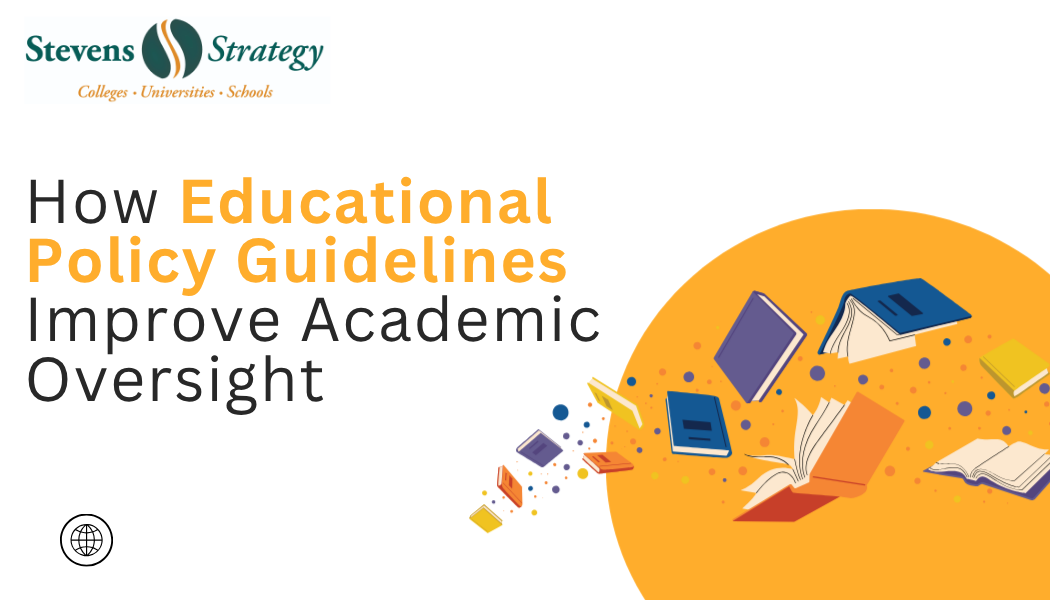By Jack Corby
Monday, November 10, 2025

Higher education governance continues to evolve amid increasing institutional complexity and intensified external evaluation. Universities are expected to demonstrate greater transparency while grounding decisions in reliable, data-informed evidence. Within this environment, educational policy guidelines have become essential instruments that define operational clarity and uphold institutional credibility. They provide the structure through which universities translate strategic intent into measurable outcomes.
Sound academic oversight depends on a strong, coherent shared governance framework that supports accountability at every administrative tier. Through refined institutional policy management, universities can maintain focus on their mission while adapting to shifting expectations and accreditation requirements. When paired with higher education compliance strategies, these mechanisms sustain long-term organizational coherence and integrity. By maintaining rigorous university operational standards, institutions not only preserve trust but also cultivate a culture of continuous improvement and responsible stewardship.
Educational Policy Guidelines: Defining Their Purpose and Scope
Every higher education institution depends on educational policy guidelines to shape how teaching, research, and administration function within a coherent system. These guidelines define expectations, clarify responsibilities, and ensure consistency across diverse departments. They serve as the blueprint that sustains academic integrity and operational clarity.
Strategic vs. Procedural Frameworks
Strategic policies articulate the institution’s long-term goals and connect governance decisions with its vision for learning and innovation. Procedural policies, in contrast, focus on execution, setting measurable standards, clarifying workflows, and ensuring adherence to university compliance procedures. The balance between both determines how effectively an institution translates intent into action.
Linking Policies to Institutional Mission
Embedding Values and Governance Ethics
Policies hold meaning only when aligned with institutional purpose. When academic institution regulations reflect academic ethics, shared values, and student-centered priorities, they strengthen the moral and operational backbone of the university. This connection between values and policy creates a sense of coherence that drives academic excellence and fair governance.
Ensuring Continuity Through Transitions
Leadership changes can disrupt institutional focus, but strong institutional policy management preserves direction and stability. Clear documentation, transparent oversight, and a consistent decision-making framework help sustain progress during transitions. With this structure in place, the university’s mission remains steady even as its leadership evolves.
The Governance Core: Structures That Uphold Oversight
A strong governance system is the foundation of institutional accountability. Effective oversight depends on deliberate structures that balance independence with responsibility, ensuring decision-making remains both informed and transparent. Within this ecosystem, shared governance serves as the mechanism that connects leadership, faculty, and staff in shaping academic direction and operational integrity.
Building a Coherent School Governance Framework
A well-defined school governance framework integrates faculty expertise with administrative strategy. It ensures that decisions reflect academic priorities while maintaining alignment with institutional mandates. Faculty members exercise autonomy in curriculum and research, while administrative leaders uphold accountability for compliance and performance outcomes.
University boards play a guiding role in this structure. They set strategic direction, allocate resources, and safeguard mission continuity while respecting the boundaries of academic freedom. This balance allows governance to function as a partnership rather than a hierarchy, reinforcing trust across all levels of the institution.
Roles and Responsibilities in Oversight
Ongoing oversight relies on mechanisms that invite continuous reflection and adaptation. The policy committee operates as the central forum for reviewing, revising, and advancing institutional standards. Through this process, university compliance procedures remain current, coherent, and responsive to emerging accreditation requirements.
Equally important is the role of faculty-staff governance. Academic senates and administrative councils work in active collaboration, ensuring that academic institution regulations are implemented effectively across departments. Their participation strengthens accountability, aligns decision-making with institutional values, and sustains an environment where academic excellence and operational compliance progress together.
Compliance as a Catalyst for Academic Quality
Compliance functions as more than a safeguard; it acts as a strategic driver of academic excellence. Institutions that integrate compliance into their daily operations cultivate accountability, consistency, and measurable improvement across every domain of higher education.
Establishing Reliability Through University Compliance Procedures
Universities reinforce quality through well-structured university compliance procedures. These systems standardize documentation, clarify expectations, and synchronize operations with accreditation benchmarks. They provide the framework that connects academic performance with regulatory standards, ensuring that institutional practices remain transparent and defensible.
- From Reaction to Readiness
Institutions are shifting from reactive compliance to a culture of anticipation. Proactive monitoring and internal evaluations align efforts with university operational standards, allowing departments to detect gaps before they escalate. This shift strengthens resilience, ensuring readiness for both national and international accreditation assessments.
Embedding Higher Education Compliance Strategies Across the Institution
A forward-looking approach embeds higher education compliance strategies within every institutional layer. Academic programs reflect these standards in curriculum planning, faculty management, and research governance. The result is a cohesive environment where policy, performance, and purpose intersect seamlessly.
- Early Risk Detection and Policy Integration
Effective compliance depends on foresight. Through continuous institutional policy management, universities create reporting systems that surface risks early. These systems turn oversight into opportunity, promoting timely adjustments, informed leadership decisions, and enduring academic integrity.
Institutional Policy Management: From Concept to Practice
Effective institutional policy management transforms abstract governance principles into measurable institutional outcomes. Policies become instruments of accountability when they are designed, maintained, and applied with clarity and intent. The process requires both precision in development and inclusivity in adoption to ensure that every stakeholder contributes to institutional coherence.
- Policy Design and Documentation
A well-structured policy begins with purpose and precision. Institutions develop enforceable frameworks through systematic planning and review, ensuring that each policy aligns with academic priorities and operational standards. Clear documentation eliminates ambiguity, guiding decision-makers toward consistent and transparent actions.
Regular audits form a critical part of this cycle. Scheduled reviews confirm that policies remain relevant amid evolving accreditation requirements and organizational changes. By embedding this discipline within university compliance procedures, institutions maintain both credibility and adaptability.
2. Dissemination and Adoption
Policy effectiveness depends on communication as much as content. Universities strengthen understanding through faculty orientation, workshops, and structured communication programs that promote awareness across all departments. These efforts ensure that institutional policies are not only accessible but also internalized as shared commitments.
Cross-departmental participation plays a decisive role in sustaining adherence. When governance bodies, faculty, and administrative units collectively assume ownership, policies become living tools that shape culture rather than static directives. This collective approach reinforces continuity, cultivates accountability, and ensures that institutional principles are translated into everyday academic practice.
Operational Standards That Define Academic Oversight
Operational excellence in higher education depends on the precision of standards that guide performance, accountability, and governance. When universities define expectations clearly, oversight shifts from reactive management to proactive quality assurance.
Establishing University Operational Standards
Purpose: To ensure every academic and administrative function supports institutional coherence.
- Measurable benchmarks translate strategic goals into quantifiable outcomes. These indicators assess teaching quality, research productivity, and service delivery.
- Oversight becomes integrated when academic, financial, and student service operations follow the same evaluative framework. Alignment under consistent standards creates transparency and predictability.
Unified oversight transforms diverse operations into a coordinated system of academic accountability.
Monitoring and Accountability Mechanisms
Purpose: To verify progress and maintain compliance through continuous evaluation.
- Data analytics now serve as the backbone of assessment. Institutions apply metrics to evaluate how effectively university operational standards uphold governance objectives.
- Executive leaders rely on real-time dashboards and performance scorecards that highlight institutional strengths, emerging risks, and compliance readiness.
Evidence-driven monitoring allows leadership to anticipate issues rather than react to them.
Policy Innovation and Institutional Agility
Higher education institutions face an era of rapid transformation. New accreditation frameworks, emerging governance models, and shifting pedagogical tools redefine what academic oversight requires. Policy must evolve not through reaction, but through foresight.
Adaptation in Motion
Each change in accreditation or learning technology demands a timely policy response. Universities that revise and refine their governance structures remain positioned for accreditation success and operational balance. Policy becomes a living document—one that evolves alongside academic methods and institutional priorities.
Flexibility as Function
Institutional adaptability relies on agile frameworks. Policies grounded in educational policy guidelines allow universities to pivot when curriculum models or delivery systems shift. This flexibility preserves consistency without constraining innovation, maintaining both compliance and creative freedom.
Collaborative Renewal
Policy improvement thrives when faculty participation becomes routine rather than occasional. Faculty councils and staff committees serve as catalysts for reform, ensuring that revisions reflect on-the-ground realities of teaching and research. Participation fosters shared ownership and strengthens institutional accountability.
Embedded Evaluation
Sustained agility depends on internal assessment. Integrating policy evaluation into planning cycles ensures that performance data informs decision-making. Through structured reflection, institutional policy management shifts from an administrative task to a strategic process that anticipates challenges rather than reacts to them.
Outcome
Policy innovation, when grounded in collaboration and responsiveness, builds institutions capable of continuous growth. Agility becomes a habit, not a reaction—a defining characteristic of governance that endures through change.
Conclusion
Educational policy guidelines shape more than administrative order; they define the ethical and operational foundation upon which integrity, transparency, and accountability rest. Through clear policies, institutions establish the standards that govern both academic rigor and institutional trust.
Effective oversight emerges where clarity meets participation. When governance bodies, faculty, and administrators share responsibility, policies evolve in response to changing conditions rather than resisting them. This continuous adaptation ensures that oversight remains relevant, credible, and aligned with the institution’s mission.
With guidance from strategic partners such as Stevens Strategy, universities can refine their governance structures, enhance compliance readiness, and cultivate resilience. Strengthened by informed leadership and structured institutional policy management, they secure both immediate accountability and enduring academic excellence


